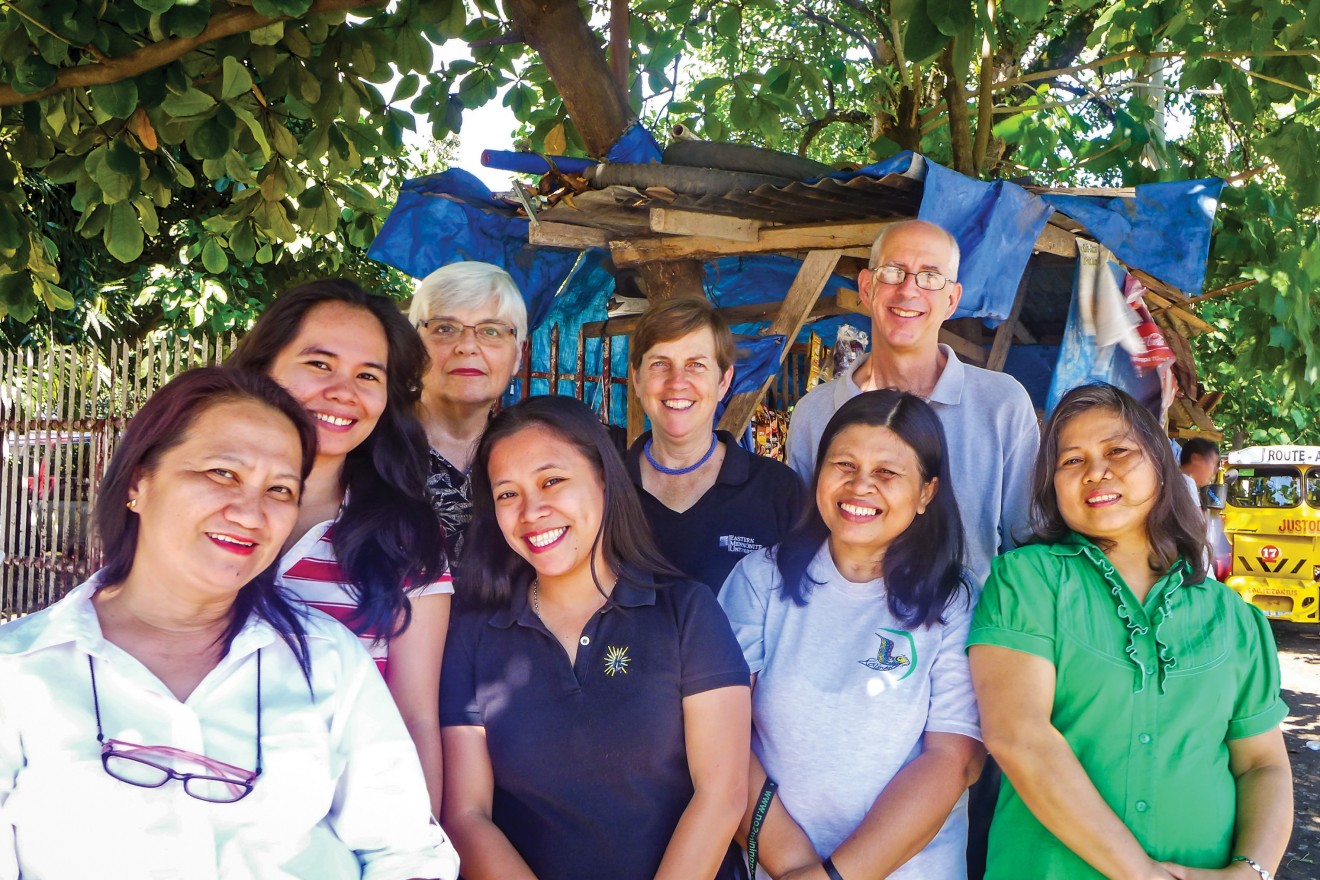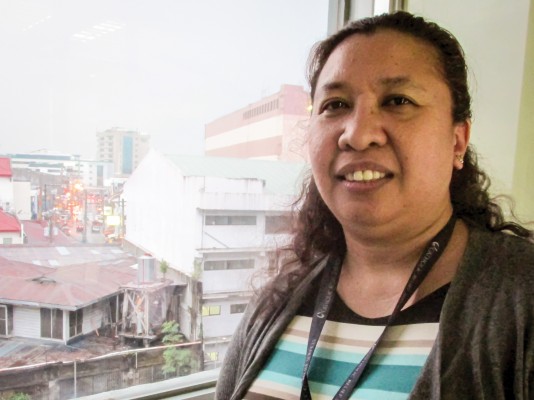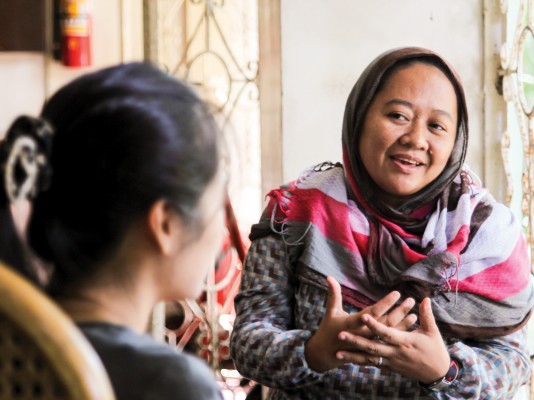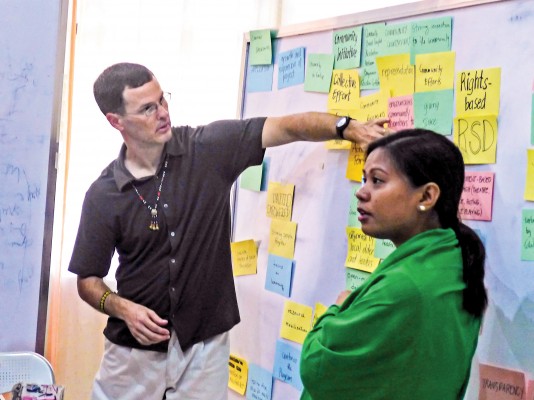
The origins of the first peacebuilding institute in Asia can be traced to a conversation in the home of John Paul and Wendy Lederach when they lived near EMU in 1998. John Paul was then the visionary behind EMU’s 4-year-old Summer Peacebuilding Institute (SPI).
Myla Leguro recalls joining seven other Filipinos around the Lederachs’ dining room table to talk about setting up a peacebuilding institute modeled after SPI in Mindanao. It would be located in the heart of the southern region of the Philippines where violent conflict had raged for generations.[1]
Two years later, the Mindanao Peacebuilding Institute (MPI) began holding summer training sessions, initially underwritten by Catholic Relief Services and Mennonite Central Committee. Two seasoned SPI instructors flew to the Philippines to teach at MPI’s inaugural year: Nancy Good (Sider), a social worker and an EMU faculty member, and Mohammed Abu-Nimer, a Muslim-Palestinian who had recently finished his PhD in the United States.[2]
Over the next dozen years, as MPI grew to have more than 1,800 alumni, Mindanao gradually moved from being convulsed by near-constant warfare to experiencing a fragile peace across much of the island.
In March 2014, the Philippine government and the Moro Islamic Liberation Front signed a comprehensive peace agreement, which paved the way for a new Muslim autonomous entity called “Bangsamoro.”[3]

Top-level peace negotiations had occurred over many decades, facilitated by leaders from largely Muslim countries. From 1976 to 1996, Indonesia facilitated the peace talks. From 1997 to the present, Malaysia has done so. Yet these negotiations also fell apart repeatedly – until the most recent series of talks leading to the 2014 agreement.
How much credit for the current shift toward peace is traceable to the efforts of MPI in training hundreds of peacebuilders – who, in turn, trained or influenced thousands of others through their religious organizations, educational systems, neighborhoods, tribes, government agencies, military networks and nonprofit organizations?
Tracing this influence is as impossible as determining exactly which molecules of water flowing in a river are traceable to a specific spring at the river’s headwaters.
Yet people knowledgeable about the decades of conflict in Mindanao point to MPI’s key role as a constantly flowing spring of peacebuilding practices in the Philippines, merging with those of other springs, such as the Kadtuntaya Foundation Inc. and Southern Christian College, both based in southern Mindanao.
Trip to Cotabato
In October 2014, the five-hour minibus journey from Davao, the commercial hub of the island of Mindanao, to and from Cotabato City required passing through multiple checkpoints staffed by heavily armed government soldiers. (Cotabato City is a densely populated urban area with a mix of Christians and Muslims, surrounded by a largely Muslim province, where rebels have fought government troops for decades.)
These soldiers looked bored, as if they were not expecting trouble. Only once were the passengers forced to disgorge themselves from their crammed-tight minivan. The only obvious Westerner among the passengers – a female reporter for Peacebuilder – had been advised to keep her head covered and to dress modestly for the duration of the trip to and from Cotabato, but the soldiers paid scant attention to this grandmother-aged woman. They seemed intent on checking everyone’s belongings for something – explosives, arms, drugs, dangerous literature? It wasn’t clear what. Apparently satisfied after 10 minutes of poking inside the van, they sternly waved everyone back inside.
In Cotabato City, Rhea Silvosa, an MPI administrator in her 20s who was acting as guide and host, urged the Westerner to stay close to the perimeter of their hotel, where security guards hovered, until time to depart for a meeting. The worry? Some Westerners had been kidnapped for ransom in recent memory.
Viewed from a slow-moving vehicle on packed streets, it felt as if Cotaboto were trying to decide if it would be a city at peace or not – and what its identity would be. Beyond a high fence surrounding a campus with the Catholic name of Notre Dame University, about three-quarters of the women appeared to be Muslim, with their heads covered by scarves. The other quarter of the women would have looked at home in Manila – with their flowing hair and tight jeans and T-shirts. Meanwhile, in the streets outside the campus, more than a few women were fully veiled, resembling women circulating publicly in Saudi Arabia.
A number of schools had draped peace-themed banners or mounted billboards at their entrances. “This school is a zone of peace” was seen more than once.
The Kadtuntaya Foundation
At the Kadtuntaya Foundation Inc., headquartered in a two-story building in a densely populated residential neighborhood, seven staff members (five men and two women) who had taken MPI courses sat around a conference table on a Saturday – normally their day off – patiently ready to answer questions for Peacebuilder.
First a bit of background about the foundation: A couple who married across faith lines – he being Muslim, she being Christian – founded this nonprofit in 1989 to “bridge the gap between the Christians and the Muslims as well as the non-Muslim indigenous tribes in Mindanao whose relationship had been strained by decades of conflict and wars,” according to Kadtuntaya Foundation literature. The organization focused in the 1990s on “facilitating dialogues” among these groups, “aimed at reducing prejudices, improving relationships, and forging mutual understanding and cooperation.”[4]

As explained by Norlyn A. Odin, a Muslim woman on Kadtuntaya’s staff, the decades of conflicts have had much more to do with socio-economic issues – such as rights to resources, livelihoods, and group identity and dignity – than with religion per se.
The ancestors of the indigenous people were in the area first. They began to be marginalized and oppressed with the advent of Muslim missionaries and the growth of trade with Muslim countries in the 1300s. With the conversion of prominent local leaders, divisions developed over many generations between the descendants of the Muslims and of those who did not embrace Islam.
Spanish colonial rule came in the mid 1500s, followed by U.S. occupation at the beginning of the 20th century. Colonialism shifted power to Christians, and programs of settling Christians in the southern Philippines began.
The Marcos dictatorship of the 1970s and early 1980s brought large-scale atrocities and unparalleled armed conflict, fracturing communal relations and displacing masses of people. The Marcos regime also appropriated Mindanao land and handed it to large numbers of Christian settlers, who displaced both indigenous people and Muslim people.
Of Kadtuntaya’s seven staffers around the conference table that Saturday, two were Christians who did interfaith work; four were from the Muslim community (including one whose Muslim-rebel father had been tortured by government soldiers and one whose husband is a policeman); and one was of indigenous background, who was active in organizing a 10,000-person march in 2008 to insist on peace negotiations between the government and rebels and a 1,000-person march in 2009, where indigenous people called for recognizing their land rights.
Kadtuntaya’s focus on dealing simultaneously with all three major groups of people – and its considerable local credibility, especially among Muslim communities – made it an ideal partner for MPI, which invited it to send representatives to Davao for intensive training in peacebuilding from the early 2000s on.
Peace trainings
Florderick T. Sanico, 35, spoke of how his Christian-settler family had lost members in the conflict – “I’m personally a victim of the violence.” Kadtuntaya sent him to MPI in 2007 and he emerged feeling transformed by the training: “If you want peace, you have to start with yourself… I need to change my advocacy and attitudes away from violence.” Under the auspices of Kadtuntaya, he went to work in “very remote areas” where he brings together Muslims and Christians in a series of MPI-like trainings called the Grassroots Peace Learning Course.
Catholic Relief Services started these trainings in 2003 to reach the widely dispersed communities affected by violence, initially using MPI-formed facilitators like Sanico, then using facilitators emerging from these trainings. More than 500 individuals from more than 200 organizations in Mindanao had come through these trainings by the close of 2014.
The trainings are comprehensive, divided into nine modules, and may take up to 10 months to complete. The first four deal with self-understanding, the theory and tools of conflict transformation (extending over two modules), and Mindanao’s history of both harmony and turbulence.
The next two modules focus on “horizontal peacebuilding” – aimed at strengthening the ability of communities to effect change (in this vein, Peacebuilder interviewees often mentioned clan-to-clan troubles and the need for projects that increase collaboration).
Two modules address “vertical peacebuilding,” aimed at helping communities at the base to influence governmental and other structures above them.
And the final, ninth module, centers on participants designing action plans for their own contexts.
Stories show results
In 2010, Catholic Relief Services published 28 autobiographical stories of module participants, mostly written in their everyday languages of Tagalog or in Cebuano-Bisaya. Twelve of the stories eventually were translated into English in a 2011 booklet titled Working for Peace: My Cloud’s Silver Lining and Other Stories by Grassroots Peacebuilders in Mindanao.
In one story, a 36-year-old woman talks about growing up in a place where killings were an everyday occurrence and then becoming a killer herself. “We did not care who got killed in the war – whether the victim was a child or an adult….
“One day, I woke up to the realization that my own kin and family had become victims of our group….I started distancing myself, moving from one place to another to start a new life.”
Eventually, she joined an organization consisting of three tribal groups, which sent her to take the Grassroots Peace Learning Course. She did the entire nine-module series and was sad when she had to say good-bye to those who studied with her – “the dear people I had grown to love, the people who accepted me despite knowing my past life.”
“While I may not be able to bring back the lives of the people who had become our victims, what is important is that I am no longer a problem to society. I am now one of those who builds peace.” She went on to describe leading seminars, dialogues and other activities to spread the lessons she learned.
Several others in the book describe laying down their guns as a result of doing the Grassroots Peace Learning Course. One Muslim man had a Christian neighbor whom he viewed as his enemy. Both neighbors ended up in the same peace-course cohort. And both changed so much that the Christian man, as he lay dying of an illness, asked the Muslim to take care of his family, a request lovingly met.
Wishing donors would visit for feedback
Lo Ivan R. Castillon is one of the eight Christians (out of 47 workers) at the Kadtuntaya Foundation Inc. He graduated from a Roman Catholic institution, Notre Dame University in Cotabato City, where 70% of the students were Muslim. He confesses, though, that he harbored “biases regarding their behavior and attitudes” until he underwent training to be a peacebuilder.
In his Kadtuntaya work, Castillon writes monitoring reports that help his organization satisfy the requirements of funders. Currently these are two Catholic organizations (CRS and CORDAID), two Dutch organizations, and two German organizations (Bread for the World and Mensen met een Missie). Personally, he is more motivated by the stories he hears rather than the “dry reports” he produces, which is why he loves to get out to the field as much as possible.
“I like to hear how people have changed their lives, overcome things, and now are positive sources of change,” said Castillon. “I like to hear women talk about how they were not recognized before in their communities and now they are leaders, about how peacebuilding makes a shy person to become a confident person.”
He wishes more donors would come see such changes for themselves – to talk to community members who have seen schisms healed, violence come to be rejected by themselves and their neighbors – and realize the importance of supporting this work over the long term. “We need to work for peace for a lifetime – there are more challenges to come. We can’t stop. This has to be a way of life.”
A trait of the Kadtuntaya Foundation is to midwife the birth of other initiatives, owned by the participants themselves. As an example, it has worked with dozens of organizations in the Consortium of Bangsamoro Civil Society, which (in turn) has helped organize early-warning, quick-response teams of farmers, fisherfolk, religious people, students and so forth to be voluntary peace monitors and advocates within their own communities across central and southwestern Mindanao. The teams are called Tiyakap Kilintad, meaning “care for peace.”
At the Christian college

Twenty-nine miles from Cotabato City resides Southern Christian College in the mid-sized city of Midsayap. One weekend morning in late October, 10 men and women assembled at the college’s lovely, tree-lined campus to offer their stories of peace work.
All but one of the 10 had taken MPI courses. Social work dean Melody Ambangan was the first from Southern Christian College to attend MPI. In 2009, six years after her first three MPI courses, she said she dug out her MPI course materials and used them to address gender issues, as well as the “anger and hurt,” affecting the 100 or so students enrolled in the College of Social Work. (She also returned to MPI in 2009 and took a course she missed in her first round: “Introduction to Conflict Transformation.”)
Each summer, the college’s Institute for Peace and Development Studies invites 30 young people (10 each from the three major populations in Mindanao) for a four-week residential summer program. Explicitly patterned after MPI, this institute has prepared more than 300 peacebuilders, who are now spread across the region as teachers, social workers, NGO employees, community volunteers, and government officials.
One of those 300 peacebuilders was at the conference table, Rodelio Ambangan, Melody’s husband. He directs the college’s Institute for Peace and Development Studies and is the chairperson of the Mindanao Peoples Peace Movement, an alliance of more than 100 organizations encompassing 30,000 to 40,000 indigenous peoples from Mindanao’s three major tribes and many smaller ones.
“I learned peacebuilding first and foremost from my home,” says Rodelio, referring to both his family home with Melody and his larger home among his peoples, the Erumanen ne Menuvu. “Indigenous people are peace loving,” he adds. Under the stress of survival threatened by conflict and natural disasters, though, some of the peace traditions have been in danger of disappearing. Rodelio works at reminding his people, “We have our own ways of doing restorative justice and it’s not just human, but also done in consultation with the Spirits.”
Peace studies and practices seem to be woven into every aspect of the college. A weekly one-hour radio show is recorded at the college that always deals with ways to transform conflict. There’s an arts for peace program with theater, music and painting components – peace-themed posters and paintings line walls everywhere. The college sponsors mixed-ethnic, inter-religion sports programs to foster peace.
Concurrent with its peace emphasis, the college deals with community building through outreach, offering literacy, health, environmental, livelihood, and gender-equality programs.
In one corner of the college campus – near the main college entrance – is a building labeled “Saranay Feeds.” This turns out to be a mill that produces animal feeds, a combined agricultural education and income-producing activity, with profits going toward student scholarships.
In municipal government
Two of the most surprising interviewees at the conference table were not formally associated with the college. Bartolome B. Lataza Jr. was introduced as the former mayor of the municipality of Alamada (population 56,000) in Cotabato province, along with his former executive secretary, Arjay Neville L. Repollo.
Lataza started his journey toward peacebuilding as an enlisted man during the martial law period (1972-81) of the Marcos dictatorship. After 22 years of military service, he retired as a major and won Alamada’s mayoral election in 1998.
Alamada was in the grip of “identity-based conflict” that manifested as spiritual and religious schisms, worsened by environmental degradation. Nearly 80% of the population lived below the official poverty line. “If we have peace, then there will be development,” Lataza and Repollo decided.
The two gathered representatives from each major group to sit and talk to each other, followed by “thanksgiving meals” (Kanduli). They found peace themes to reference in the Bible and Quran and indigenous traditions. They let everyone speak freely about their realities, about their victimization. They encouraged all municipal employees to go and “listen to the cries, hear the sentiments of the IDP [internally displaced peoples].”
In 2011 and 2012, Lataza and Repollo attended MPI, taking courses in restorative justice, religion and conflict, trauma healing, peace and justice advocacy, and arts-based peacebuilding.
Today Alamada is a relatively peaceful municipality, where alternative dispute resolution is practiced and governing occurs transparently.
“People say that investing in peace is expensive,” says former mayor Lataza, who also served multiple terms as city counselor and vice mayor. “But how much more expensive are war damages to businesses, [are] traumas, [are] thousands of IDPs?”
Repollo says he learned that a different kind of power comes from peacebuilding. “You are more powerful because you are tranquil as a peacebuilder. You can be a lamb in the lion’s den if you are a peacebuilder.
“Peacebuilding is a way of life, though it is a way that requires training and experience,” he says.
Mindanao Peacebuilding Institute at age 15

Catholic Relief Services in Davao physically housed the Mindanao Peacebuilding Institute for its first nine years of existence. It ran the annual trainings and provided support services, such as bookkeeping, as well as some funding. Additional funders during most of MPI’s years have been the Catholic Agency for Overseas Development and Mennonite
Central Committee. (MCC continues to offer support by sending participants regularly to MPI’s annual training.)
In 2009, MPI became a free-standing nonprofit, as originally envisioned by its founders, under the direction of Christine Vertucci. In the following four years, MPI experienced considerable staff turnover and financial challenges.
MPI is now finding its footing again as a peacebuilding institute serving a wide geographical region, attracting the majority of it trainees from outside of the Philippines, says Vertucci.
It also collaborates with other peacebuilding institutes, such as the Peacebuilding and Development Institute in Sri Lanka and the Northeast Asia Regional Peacebuilding Institute. The former institute got its start from former SPI instructor Mohammed Abu-Nimer; one of his students, Saji Prelis; and Maharuf, an MPI alumnus.
“Today MPI is pointed in three main directions – (1) education and training, (2) networking, and (3) research and documentation,” Vertucci says. Of these three, she admits that the last is more of an aspiration than an accomplishment. With MPI’s funding largely dependent on fees charged for attending courses, MPI has lacked the budget line to research and document the impact of its trainees over the last 15 years.
Vertucci’s links to MPI go way back. She served on the founding committee of MPI in her previous role as the country representative for MCC. She was an early attender at EMU’s SPI, taking a course in 1996 with John Paul Lederach to prepare for her MCC work in the Philippines. She returned in 1998 for two courses– with Hizkias Assefa on reconciliation and with Vernon Jantzi on organizational conflict.
Vertucci is not averse to MPI working its way out of a job in the Philippines – given that its graduates widely replicate MPI’s work on the local level – but she thinks that day hasn’t yet arrived, not with people from Cambodia, Vietnam, Laos, Indonesia, Myanmar and so forth (not to mention a number of African countries) still coming for training.
Born of U.S. parents, but raised and permanently settled in the Philippines, Jeremy Simons, MA ’02, was a member of MPI’s staff from 2011 to 2013 and continues to teach an MPI course each summer. “MPI has the power to be a convener, having trained so many people,” says Simons. He notes that MPI’s caliber of trainers, with most holding advanced degrees in the peace field, enables it to offer a comprehensive level of training that cannot be matched by other organizations in the Philippines.
He points to unmet needs for MPI’s trainings both within the Philippines and without – to the need for alternative dispute resolution spread through court systems, restorative disciplinary practices introduced to schools, trauma-healing for almost everyone, much more work with the military and the police on how to be forces for peace rather than violence.
Which leads us back to the observation of former mayor Lataza: the Mindanao Peacebuilding Institute just needs to show that it’s much more cost-effective for donors to invest in peacebuilding, rather than focusing on fixing the damage emerging from human-made or human-worsened disasters.
Footnotes
- The eight Filipinos were: two Mindanao bishops, Abp Ledesma and Bp Dela Cruz; two Muslim religious leaders, Alim Elias Macarandas (deceased) and Alim Julabbi; two Civil Society Organization peace advocates, Guiamel Alim and Deng Giguiento; and two Catholic Relief Services staffers, Myla Leguro and Peter Rothrock.
- Mohammed Abu-Nimer went on to found his own peacebuilding institute at American University in Washington D.C., which ceased functioning in 2013, as described on page 44.
- Political and social hurdles remain for this agreement: the Philippine Congress must ratify it, followed by a plebiscite of voters in the affected region. A major setback occurred January 25, 2015, when the elite “Special Action Force” of the Philippine National Police launched an anti-terrorist operation in an area occupied by Muslim rebel groups. The operation was interpreted as a broader attack on groups that had agreed to a ceasefire. Fighting ensued. At the end of the day, 44 police and 23 rebels lay dead. Despite this, many leaders have urged that the peace process continue.
- In addition to its peace focus, Kadtuntaya promotes sustainable livelihoods and disaster risk-reduction (necessitated particularly by climate change), including promoting environmentally friendly farming and the production of marketable handicrafts.